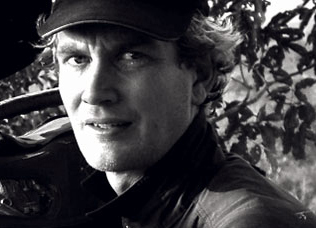
The Blue Planet is a British nature documentary series created and co-produced by the BBC and Discovery Channel. It premiered on 12 September 2001 in the United Kingdom. It is narrated by David Attenborough.

Animal Planet is an American multinational pay television channel, and associated AnimalPlanet.com website content, owned by the Warner Bros. Discovery Networks unit of Warner Bros. Discovery. First established on June 1, 1996, the channel is primarily devoted to series and documentaries about wild animals and domestic pets.

Planet Earth is a 2006 British television series produced by the BBC Natural History Unit. Five years in the making, it was the most expensive nature documentary series ever commissioned by the BBC and also the first to be filmed in high definition. The series received multiple awards, including four Emmy Awards, a Peabody Award, and an award from the Royal Television Society.

Nature photography is a wide range of photography taken outdoors and devoted to displaying natural elements such as landscapes, wildlife, plants, and close-ups of natural scenes and textures. Nature photography tends to put a stronger emphasis on the aesthetic value of the photo than other photography genres, such as photojournalism and documentary photography.
Sunrise Earth is a nature documentary television series that last aired in the United States in 2008 on HD Theater, which has since been reformatted and rebranded as Velocity. The series focused on presenting the viewer with sunrises in various geographical locations throughout the world. It is also notable for its complete lack of human narration, concentrating instead on the natural sounds of each episodes' specific location. High-definition video and Dolby 5.1 stereo surround sound are used to present each natural environment in a clear and detailed manner. The show is an example of the genre known as "Experiential TV", developed by series creator David Conover. The technique has been described by TV critic Tom Shales as "crazily uneventful and thoroughly wonderful."
Tristan Bayer is an American actor, filmmaker and the host of the Animal Planet series Caught in the Moment, and was nominated for an Emmy for individual achievement in a craft: cinematography.

U2 3D is a 2008 American-produced 3D concert film featuring rock band U2 performing during the Vertigo Tour in 2006. Directed by Catherine Owens and Mark Pellington, the film contains performances of 14 songs, including tracks from How to Dismantle an Atomic Bomb (2004), the album that the tour supported. The concert footage includes political and social statements made during the shows. It is the band's second feature film, following their 1988 rockumentary Rattle and Hum. Among several cinematic firsts, U2 3D was the first live-action digital 3D film.

Timothy Allen is an English photographer and filmmaker best known for his work with indigenous people and isolated communities around the world.

Wild Africa is a British nature documentary series created and produced by the BBC. It explores the natural history of the African continent. It was first transmitted on 7 November 2001 on BBC Two in the United Kingdom and comprises six episodes. Each concentrates on a particular environment. The producers use aerial photography and wildlife footage to show how natural phenomena such as seasonal changes influence the patterns of life. Wild Africa was produced by the BBC Natural History Unit and narrated by Fergal Keane.
Equitrekking is the Emmy award-winning equestrian themed travel television show on public television. Myrtle Beach, South Carolina native Darley Newman, the show's host, writer and producer, and a 2001 graduate of George Washington University, takes viewers to locations around the world for horseback riding and other adventure activities with local people. The show features tourist-friendly ranches, trail rides, horse breeds, and equestrian events, as well as a variety of locations in the United States and abroad. The series visits off the beaten path destinations with local people to give viewers a greater sense of the history and culture of each locale.

Life is a British nature documentary series created and produced by the BBC in association with The Open University. It was first broadcast as part of the BBC's Darwin Season on BBC One and BBC HD from October to December 2009. The series takes a global view of the specialised strategies and extreme behaviour that living things have developed in order to survive; what Charles Darwin termed "the struggle for existence". Four years in the making, the series was shot entirely in high definition.

Gordon John Buchanan is a Scottish wildlife cameraman, filmmaker and presenter. His work includes the nature documentaries Tribes, Predators & Me, The Polar Bear Family & Me and Life in the Snow.

Nature's Great Events is a wildlife documentary series made for BBC television, first shown in the UK on BBC One and BBC HD in February 2009. The series looks at how seasonal changes powered by the sun cause shifting weather patterns and ocean currents, which in turn create the conditions for some of the planet's most spectacular wildlife events. Each episode focuses on the challenges and opportunities these changes present to a few key species.

Christian Baumeister is a German cinematographer and award-winning director focusing on nature and wildlife productions.

NUTV at the University of Calgary is one of the oldest university-based television production societies in Canada. Established in 1983 and incorporated in 1991, NUTV is a campus-based non-profit organization that offers opportunities to University of Calgary students and community members to explore the medium of television by learning the various stages of production. These opportunities include reporting/interviewing, hosting, writing, camera operation, lighting, sound mixing, using Final Cut Pro & Adobe Creative Suite, editing, producing, and directing. NUTV is part of the University of Calgary Tri-Media Alliance, composed of print, radio, and television (NUTV). The University of Calgary is unique in that it is one of only two Canadian universities that house three media operations on-campus, the other being the University of Toronto Mississauga's UTM/TV.
Dave Currey is a British environmentalist, writer and photographer. A minister's son, he was born in Sussex in the UK and brought up in London. He gained a BA in Photographic Arts in 1976 following a passion in communicating visually. In 1976, following another passion, he walked 1,000 miles across Oregon, Idaho and Wyoming to help raise awareness of conservation issues for the World Wildlife Fund. On this journey his photographs, radio and television interviews were his introduction to a world of media co-operation that would steer his next thirty years in environmental activism.

Ice Pilots NWT is a reality television series broadcast on History Television that portrayed Buffalo Airways, an airline based in Yellowknife, Northwest Territories, Canada. Buffalo mainly flies WWII-era piston powered propeller planes as well as Lockheed L-188 Electra turboprop aircraft year-round in northern Canada. The show ran from November 18, 2009, to December 17, 2014, comprising six seasons.

The Great Rift: Africa's Wild Heart is a British nature documentary series, which began airing on BBC Two on 24 January 2010. A BBC/Animal Planet co-production, the three-part series focuses on the landscape and wildlife of the Great Rift Valley in East Africa. At the end of each fifty-minute episode, a ten-minute featurette, Inside The Great Rift, takes a behind-the-scenes look at the challenges of filming the series.

Animal Planet is a Dutch pay television channel broadcasting nature-related documentaries in the Netherlands and Flanders. The channel launched as a Pan-European feed on 1 July 1997. It is operated by Discovery Benelux.
America the Beautiful is a documentary television series dedicated to showcase North America's natural diversity and extreme conditions. The series is narrated by Michael B. Jordan and premiered on Disney+ on July 4, 2022, as a Disney+ Original, under the National Geographic banner. The series was removed from Disney+ on May 26, 2023.














